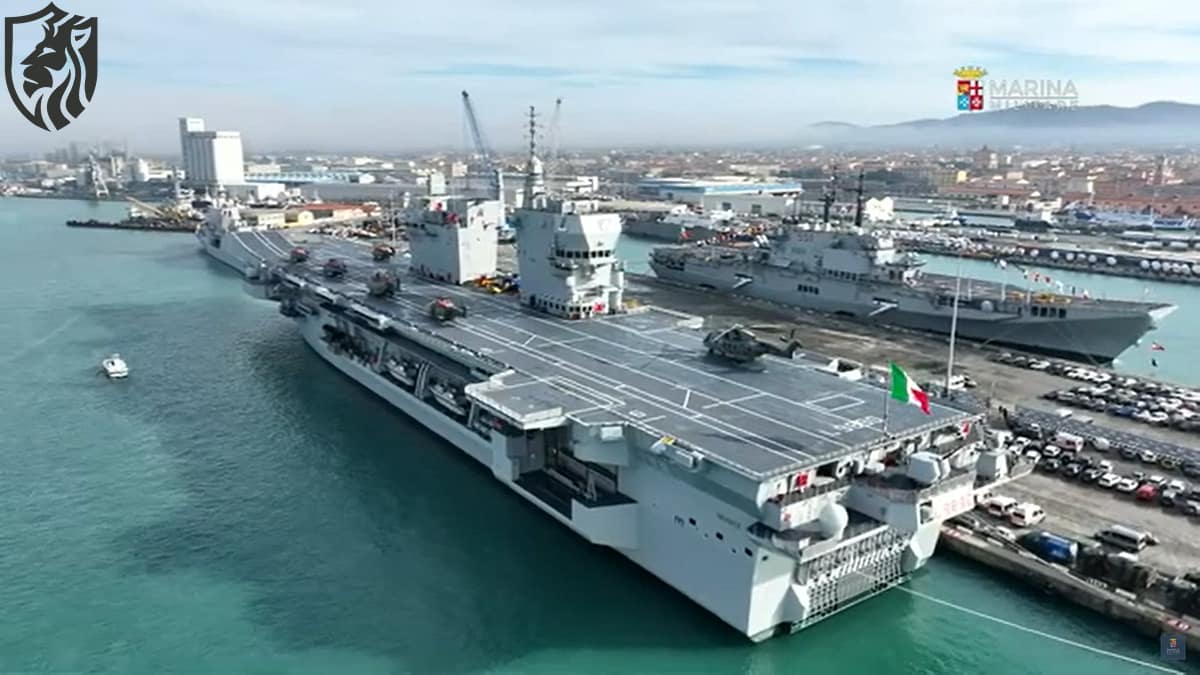
Giuseppe Garibaldi Aircraft Carrier
During the Indodefense 2025 exhibition in Jakarta, from June 11 to 14, Indonesia’s premier defense firm, REPUBLIKORP, in collaboration with local shipyard PT Palindo Marine, showcased a scale model of a naval fleet at its booth.
The exhibit showcased a hypothetical aircraft carrier, a stealth corvette, a miniature submarine, a rapid attack vessel, and an unmanned surface vehicle (USV).
Indonesia Observes Procurement of the Giuseppe Garibaldi Aircraft Carrier
The aircraft carrier model identified it as “Giuseppe Garibaldi,” denoting the former flagship of the Italian Navy. Nevertheless, the mock-up exhibited minimal similarity to the actual Giuseppe Garibaldi light aircraft carrier, indicating it was a conceptual design rather than an exact replica.

In light of reports regarding the Indonesian Navy’s (TNI AL) increasing interest in acquiring an aircraft carrier, Naval News visited the Fincantieri booth to gather information on prospective developments.
In an interview with Naval News, Mr. Mauro Mansini, Director of Sales for Fincantieri’s Naval Business Unit, affirmed that the Indonesian Navy has shown interest in procuring the Giuseppe Garibaldi.
He stated that the two governments are currently deliberating the issue at the “state level” and have not yet reached an official decision on the procurement.
The Giuseppe Garibaldi is in satisfactory condition and possesses approximately 15 to 20 years of remaining operational lifespan. Upon reaching an agreement, the vessel may be transferred to a refit process tailored to the Indonesian Navy’s particular specifications.
Mauro Mansini, Director of Sales for the Naval Business Unit at Fincantieri, underscored the ship’s versatility, asserting that Giuseppe Garibaldi can operate various platforms, including drones, helicopters, fixed-wing aircraft, and amphibious assets.
“It has demonstrated effectiveness in humanitarian and disaster relief operations,” he noted, referencing the vessel’s role in providing medical aid and humanitarian supplies after the 2010 Haiti earthquake.
TB3 UCAVs Aboard Garibaldi
Baykar Technologies presented scale models of its Bayraktar TB3 UCAV at the REPUBLIKORP exhibition booth. Alongside them, the team also displayed a detailed aircraft carrier model, showcasing Turkey’s expanding naval UAV ambitions.
The TB3, designed for short take-off, suits aircraft carriers and LHDs like the Turkish Navy’s flagship, TCG Anadolu. Currently, engineers are testing the TB3 on the Anadolu, marking a major milestone in naval drone integration. The stand also displayed a complete model of the TB3 with multiple payload configurations for mission versatility.
In addition, Baykar included scale models of its AKINCI UAV on the carrier display platform. But because it was not designed for maritime operations, AKINCI is unable to launch or recover from a carrier.
Therefore, Baykar likely showcased the AKINCI for illustrative or promotional purposes, not as an operational fit. Even so, its presence demonstrated Baykar’s wide drone portfolio and Turkey’s ambitious vision for unmanned systems at sea.
Ultimately, Baykar’s exhibit highlighted Turkey’s rapid progress in naval UAV development and deployment. As TB3 testing continues on the TCG Anadolu, Turkey inches closer to operationalizing carrier-launched unmanned airpower.
This development represents an important shift in regional naval strategy, especially as few nations operate armed carrier-based drones.
Baykar’s expanding role
Baykar’s expanding role also reflects how Turkish defense firms now compete on a global stage with cutting-edge UAV technology. If successful, the TB3 will give Turkey a unique advantage in projecting power from sea-based platforms.

Indonesia has shown a great deal of interest in the Bayraktar TB3, Baykar Tech officials told Naval News during the exhibition.
We have signed a preliminary agreement for the acquisition of 60 drones, and we are currently negotiating the final contract. The officials stated that this 60-UAV package comprises both maritime and terrestrial variants of the TB3.
This is the first official confirmation that the TB3, once described as a carrier-ready upgrade of the TB2, has two versions. Company officials said the land-based model offers higher takeoff weight, larger fuel storage, and longer endurance than the naval version.






